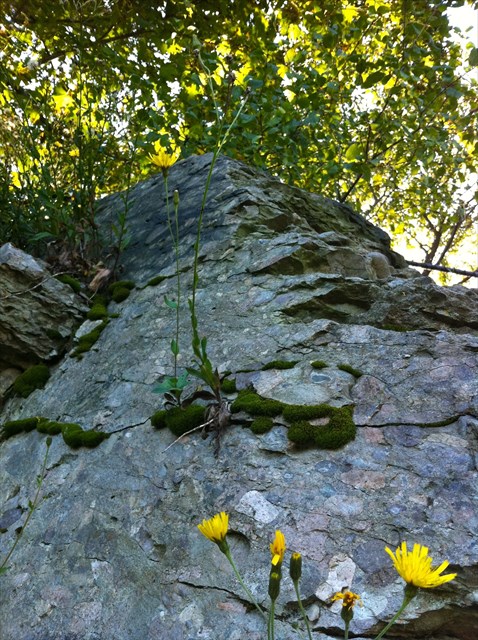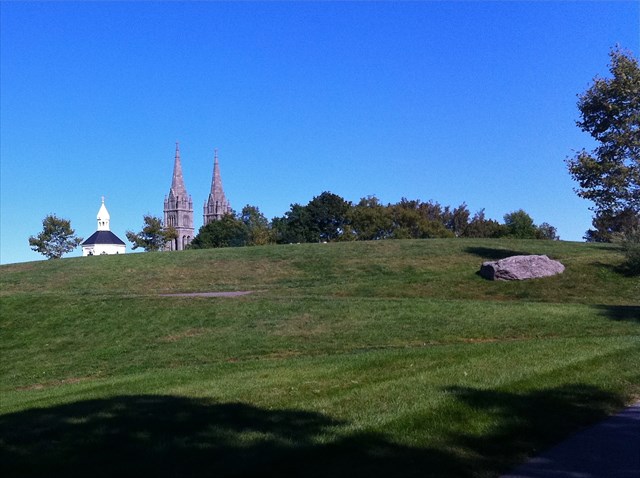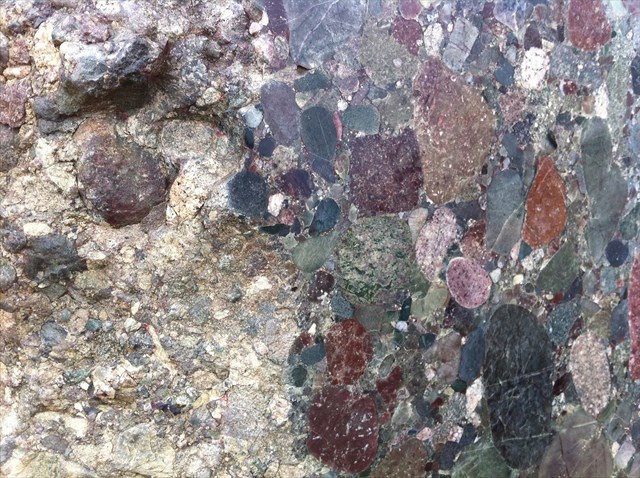
Plums in the Pudding
"Plums in the Pudding"* is a series of developing Earthcaches which, in various ways, hopes to inform and inspire the cacher about Massachusetts' unique and fascinating state rock, Roxbury Puddingstone. Further, whenever possible, this series will use locations that are wheelchair accessible to accomplish its goals.
"Plums in the Pudding I" takes you to the Mission Hill area of Roxbury. A Boston neighborhood curiously not named for a town in England (as many local towns and neighborhoods are), Roxbury (originally Rocksbury) was named for the very conglomerate rock (also referred to as "puddingstone") abundantly found here. Hence, a fitting place to commence our journey!
"I wonder whether the boys (and girls) who live in Roxbury and Dorchester are ever moved to tears or filled with silent awe as they look upon the rocks and fragments of the 'puddingstone' abounding in those localities…. Yet a lump of puddinstone is a thing to look at, to think about, to study over, to dream upon, to go crazy with, to beat one's brains out against. Look at that pebble in it. From what cliff was it broken? On what beach rolled by the waves of what ocean? How and when imbedded in soft ooze, which itself became stone, and by-and-by was lifted into bald summits and steep cliffs… and mark the scratches on their faces left when the boulder-carrying glaciers planed the surface of the continent with such rough tools that the storms have not worn the marks out of it with the polishing of ever so many thousand years?"
- Oliver Wendell Holmes, Sr.
The Professor at the Breakfast Table (1859)

The Park
The posted coordinates take you to the entrance of the Kevin W. Fitzgerald Park (formerly Puddingstone Park), a 5.5 acre community park in the heart of puddingstone territory. Here, it is hoped, you will embark on a journey exploring not only Roxbury Puddingstone's technical geology but also its awe-inspiring saga and mystery, those illusive features that captured Mr. Holmes and generations of others, including me!
As you wander along the paths, you will notice garden specimens and natural outcroppings of unusual rocks that look like some ancient cementing together of smaller stones. This, in fact, is what Roxbury Conglomerate (Puddingstone) is: boulders and pebbles (clasts), tumbled and smoothed over time and travel (impressive time and travel), held together by a finer-grained matrix (the 'cement' part**) after moving tectonic plates rearranged landmasses, with monumental collisions and separations en route, eventually depositing the rock here, where it later met the glaciers.
The epic... Once located in the Southern Hemisphere and part of the ancient African coast, a volcanic island chain (Avalonia) rifted from its African base. While Avalonia was located off the coast (some six hundred million years ago), the rocks of the Boston Basin, including the Roxbury Conglomerate, formed upon it. Avalonia (along with the landmass Baltica, later to become parts of Europe) then drifted northward, across what was then the Iapetus Ocean, the two softly bumping each other along the way, both eventually colliding with the small continent Laurentia (located at the equator). This collision caused a major mountain-building event and Laurentia became Laurussia, later forming Pangaea after it collided with Gondwana (from which Avalonia rifted in the first place). Whew! The eventual rifting of Pangaea produced the Atlantic Ocean. At that same time, the Boston Basin, a small part of what became the Southeastern New England Avalon Zone (other parts of Avalonia ending up elsewhere), found its home on the coast of eastern North America. The final steps, towards the creation of the puddingstone, came with the arrival and departure (and tremendous erosion-causing movement) of the glaciers, a mere ten thousand years ago.
So the story goes, with many aspects of the ancient stone's origins remaining controversial and unknown. Six hundred million years from the start of their spectacular journey, these rocks alone know their full story, for us "a thing...to think about, to study over, to dream upon...."
Forming the bedrock of much of southwestern Boston and nearby surrounds, the resulting Roxbury Puddingstone continues to be widely visible in natural outcroppings and buildings here. (Once you start looking, you'll see it everywhere!) You will notice that clasts (the embedded stones) within the matrix are different sizes and degrees of roundedness. Those bits that traveled most extensively tend to be more rounded, their less-traveled cousins more angular. In turn, these features give clues to their age. Of course, modern dating technology is more sophisticated/can probe deeper, physically. But this is a journey not only of technical science but also of sentiment and the resulting awe evoked by the simply observable. So, we embrace both!
Before leaving the park and as you take in the views, don't forget to notice nearby Mission Church, your next destination! Also, along the way, be sure to look for puddingstone foundations visible in the older residential buildings.
But first, peeking inside the rock...
The next photo, taken in the rock garden at the entrance of Boston's Museum of Science, offers a rare glimpse of polished Roxbury Puddingstone adjacent to the stone's unpolished surface. The richly colored mosaic-like surface of the polished rock highlights the several kinds of rocks that make up puddingstone. Notice, also, how many kinds of clasts appear within the rocks and ledges you find in the park.

The Church
The second set of coordinates (see additional waypoint) will bring you to nearby Mission Church, rich with history long past and more recent. (The church was founded in 1874 at the request of Fr. Robert Healy, later to become probably the first African American Catholic bishop in America; the church also was chosen for the funeral of Senator Edward M. Kennedy in 2009).
The current Romanesque revival structure was built of puddingstone in 1876 by the architectural firm Schickel and Ditmars, in association with architect Edward Welby Pugin, (the towers added in 1910 by architect Franz Joseph Untersee). The stone church replaced a modest structure of wood built by the Redemptionist Fathers after establishing a mission here in 1869. Of further historical note, the church was granted basilica status in 1956 by Pope Pius XII and remains the only Catholic basilica in New England. Architecturally interesting and because the church foundation is sloped, one spire is two feet taller than its twin. Still, with all its prestigious history, Mission Church is best known as a sentimented symbol that gave the neighborhood its name.
Both Kevin W. Fitzpatrick Park and Mission Church (Our Lady of Perpetual Help basilica) sit atop the former McCarthy's Parker Hill quarry, active during the late 19th and early 20th centuries. In fact, you still can see quarry ledges, especially dramatic when viewed from the shopping district in Brigham Circle below. Characteristic of the time, and given stones had to be moved by horse or ox team, the stone for the basilica was quarried from this nearby source.
Curiously, conglomerate usually is not an appropriate choice for building since it tends to fall apart but Roxbury Puddingstone is an exception, having superior strength and moisture resistance due to its being particularly well 'cemented' together, another distinguishing feature of this extraordinary stone!
And so ends this chapter of "Plums in Pudding." I hope you enjoyed it! Discover… and dream… on!
Logging Requirements
Please do not post answers in logs. Please send your answers in a private message.
1. In the park, find the puddingstone garden rock on your right as you enter the park. What would you estimate its width (longest horizontal span) to be?
2. Also in the park, find a puddingstone garden rock or ledge that catches you. How many kinds of embedded rocks (clasts) do you see in a dinner plate size (10") area? How can you tell the difference?
3. Among the examples of puddingstone you find in the park, what size do you estimate the largest and smallest clasts (rocks within the matrix) to be? Provide coordinates for the location of each find.
4. How does the puddingstone used in the church building differ from that seen in the park?
5. Check out the stone at the corners of the church. Is the rock puddingstone? How can you tell?
6. Are the spires of the church made of puddingstone? Explain.
7. (Optional) From your experience today (or previously) and using any information posted in this Earthcache description, state in your own words what about puddingstone most captures your mind and imagination. Why?
8. (Optional) You are welcome to post photos, including of yourself, your GPS and/or your alter ego, from the park and/or at the church, but please be respectful of both locations and avoid spoilers in your photos and logs.
P.S. For an example of a realtively large natural outcropping of Roxbury Puddingstone in a nearby small wooded area (not wheelchair accessible), visit Jamaica Plain's Nira Rock Park (where you also can find two caches, including another Earthcache). Daytime only and exercise due caution.
References:
*Earthcache Series Title: The expression "plums in the pudding" was offered by Oliver Wendell Holmes Sr., endearingly translating the original inspiration for puddingstone's name, its similarly to Christmas pudding.
**Geologists actually make a distinction between the terms "matrix" and "cement" but for our current descriptive purpose no distinction is being made.
Dr. Jack Share, whose geological knowledge, reference and enthusiasm have been most valuable and inspiring:
http://written-in-stone-seen-through-my-lens.blogspot.com/2011/03/architectural-geology-of-boston-roxbury.html
Museum of Science rock garden exhibit and publication: http://www.mos.org/media/docs/MOS_Rock_Garden_Map.pdf
City of Boston, Puddingstone Map: http://www.cityofboston.gov/parks/pdfs/os7amaps1.pdf
Kevin W. Fitzgerald Park: http://missionhillnhs.org/puddingstone-park/
Mission Church: Informational plaques outside the church and Wikipedia (less reliable) http://en.wikipedia.org/wiki/Basilica_and_Shrine_of_Our_Lady_of_Perpetual_Help
Photos: foragess
| I have earned GSA's highest level: |
 |
Congratulations to gw0143 for being FTF (first to meet logging requirements)!